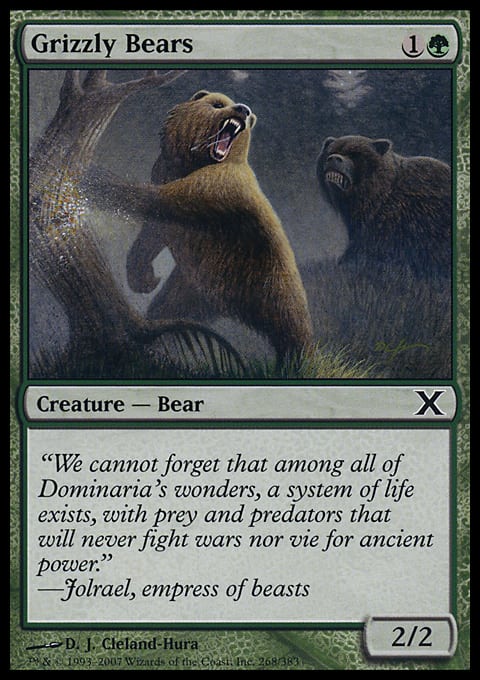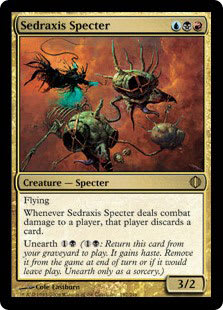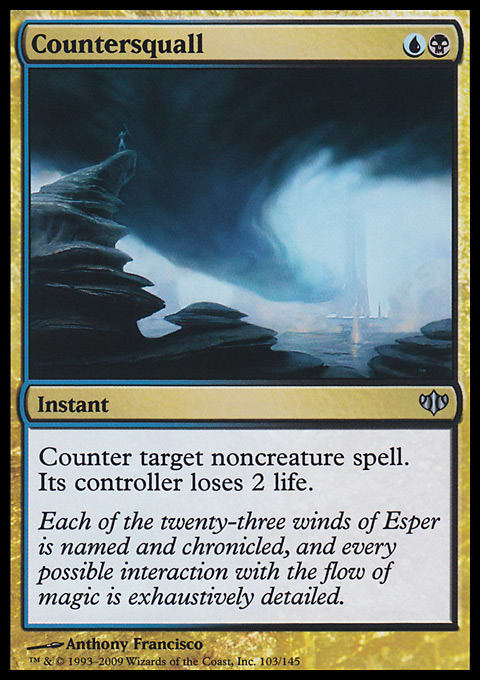Barbarian Class:
Many players realize that they are racing at all times. At least, if you asked them, they would say "Sure, of course I'm racing."
With whom are they racing? Presumably the opponent.
What are they racing to? Getting the opponent to zero before they get you to zero? This is generally but not always the race at hand.
Two things are important to understand. First is that yes, you are indeed, probably racing even if you didn't realize it. Second is that rather than blindly throwing all of your resources into offense, there are some tools that you can use to identify the race you're in, and optimize the decisions you make when you are there.
Attacking with Everything
Pro Tour Champion, Team World Champion, and in-FAMOUS Golden Age heel Mike Long used to teach that when you didn't know what to do... You should just attack with everything and see what happened.
This is a losing strategy.
Oh, don't get me wrong... It can work out sometimes! Sometimes attacking with everything is actually the best thing to do! But as a general statement, Mike's suggestion is a strategy for losers for two reasons:
- This works best if you're actually losing. You feel like you're behind and if something doesn't go right - often something either out of your direct control or something you can't quite wrap your head around - you're going to lose. Scare the opponent! Give the opponent the opportunity to screw up! Attack with everything! ... See what happens? This is quite different from attacking with everything when you know what is likely to happen. You do it when you're literally a predicted loser.
- The inherent engine of Magic: The Gathering favors defense.
Magic is the opposite of a lot of other games when it comes to attacking versus defending. In some games, heroes can be set up to go after particular defenders (and they do so usually when they're predicted to get a winning outcome). This was how Vs. System, Magic's onetime challenger in the competitive paper TCG market, set up more tactical combat.
Today, in the mobile game I play most often outside of Magic: The Gathering, Marvel: Contest of Champions, it is possible to see the opponent's entire defensive map before you even choose your team! You can line up your kill squad to have the perfect Avengers to counter their dastardly, um, X-Men or Inhumans. Do they have a pointy-arrowed archer like Disney Plus Hawkeye or a katana-wielding maniac like movie Hawkeye on D? Choose a robot who doesn't bleed like Vision or Ultron to take away some of their special sauce. Are they planning to hold down the fort with the mighty Colossus or adamantium-boned Wolverine? You can come in with the mutant master of magnetism on offense as a preemptive counter... After you've already looked.
Magic is the complete opposite. When the attacker comes in, the defender can - all other things held equal - set up favorable trades, or even no trades at all. Putting the defender into a disadvantageous position is actually not natural to Magic's fundamentals; it requires good luck, planning, or work.
Still, attacking with everything is an important tool to have in your quiver.
Creating a Breakpoint Through Creature Combat
One of the things that even experienced players tend to do badly is attack and block in Limited. Part of that is because they don't understand the concept of breakpoints. This is not surprising, because to the best of my knowledge, no one has explicitly ever talked about breakpoints in Magic: The Gathering before.
I'm borrowing the term breakpoint from Pokémon Go theory. I assume you've heard of Pokémon Go even if you've never played it; if you've played it I have no idea how serious you ever were about it. Suffice it to say there are nerds out there who know exactly how much damage each type of Pokémon at each level does to each other kind of Pokémon trying to hold down the local gym, and over what time frame. They're as geeked out about that as you are nuanced in your opinion about the virtues of Noble Hierarch versus Birds of Paradise.
Other games like Plants Vs. Zombies use similar principles as Pokémon Go for attacking and defense. They concern themselves with damage output over specific periods of time (usually damage-per-second). In Pokémon Go, you only have a certain amount of time to win a raid. In Plants vs. Zombies, it takes the rotting brain-gobblers a certain amount of time to cross your lawn. So, damage in the abstract is interesting, but it's only one component to formulating your offense or defense.
It turns out Magic has similar time-bound metrics and incentives to these kinds of games, but we never talk about them because Magic on the whole never developed very specific language around racing.
I'm using breakpoints here as an exceedingly simplified - but hopefully still useful - concept that should help your racing decision making.
For our purposes a breakpoint will be the exact exertion of resources required to force a specific outcome, relative to a certain amount of time (probably measured in turns). A kill is not the only outcome, but it's one of the easiest to visualize. It can be the number of cards you use or the number of attackers you send; what is important is that both your use and the outcome are specific.
Let's look at a really simple example.
The opponent has two 2/2 creatures and you have five 1/1 creatures.
1. What if the opponent is at 19 life?
I would argue that you are nowhere near the information required to develop a meaningful breakpoint.
2. What if the opponent is at 1 life?
Under most circumstances you are actually already past a breakpoint. Outside other information you have multiple lethal attacks on the battlefield. If you attack with three of your 1/1 creatures, it looks good for team Soldier Tokens. You might attack with all five because you're an aficionado of Mike Long, or because you really, really want to kill them dead. You're in overload mode. Depending on how many cards they have in hand it might make sense to attack with only three; all five; or the one number in-between. It might also matter if you're at exactly three life. Note that from your side there is probably no difference between exactly one and exactly two.
3. Now what if the opponent is at 4 life?
That's an actually interesting life total, isn't it? You don't have enough on the table to kill the opponent if all they do is block, but you do have enough to create a one-turn clock, if you send the whole team.
If you attack with all of your creatures, presumably the opponent will block and kill two; take three, and go to one. You will be left with three creatures, which, hopefully, will put you in a very favorable "attack with everything and see what happens" situation next turn. Note that in this hypothetical, attacking with everything (in order to attack with everything) has a very specific series of agendas; you do technically still need to see what happens, but you know ahead of time what you want to happen.
On the other hand, attacking with one or two creatures will be counterproductive. Three will put them to three, but likely in an increasingly untenable situation on the battlefield. If you send four, you will presumably put them to two... Which means next turn they'll have two dominating blockers to your three attackers... and one seemingly unachievable last point of life.
There might be very good reasons in-game to choose some number other than five attackers; Magic is a complicated game after all, but hopefully you can see how only by attacking with all five, given the information at hand, do you create the next-turn breakpoint.
Breakpoints in Deck Design
In 2010 I won the New York Nationals Qualifier with a new take on Grixis Control. Like many other Grixis decks of the day I played Jace, the Mind Sculptor and Terminate... But my choices differed wildly from that point.
Unlike the more overtly controlling (and for the format, probably worse) takes on the color combination, I ran proactive cards... starting with borrowing Blightning from Jund. I liked Blightning so much that I played the Grixis-only Blightning proxy Sedraxis Specter. Who plays Sedraxis Specter? Who has even heard of Sedraxis Specter?
At that point I realized something very specific. My deck had a lot of base-three damage. Lightning Bolt. Blightning. Sedraxis Specter; the back half of Sedraxis Specter... Even my creature land Creeping Tar Pit.
3... 3... 3... I was going to get to 18 quite naturally. 18 is not 20; and while I didn't have a word for it yet, the natural progression up - to 21 - was also not 20.
Most players disregard total damage output from control decks entirely at this point in the exercise. And to some degree, it's natural. 21, 24, or 42 are all kind of the same number if you assume control just wins all the games that it survives to a certain point, "takes total control of the game" and can start landing haymakers; regardless of how much damage they are doing, specifically.
That's all well and good, if you only want to use 79% of the tools available to you. Then consider the best creature in Standard at the time was Bloodbraid Elf - which both had haste and was naturally Counterspell-resistant - and that Vengevine (another hasty, permission-resistant, and naturally card advantageous threat) was making its debut at the same tournament.
So, what I figured out was this card:
I got a lot of weird looks for playing Countersquall.
"Why don't you just play Negate?"
"Countersquall does two damage."
"But you're a control deck."
"But Countersquall does two damage!"
If you're in the camp that 21, 24, and 42 are all the same number for control decks that have well and truly gained control... I won't disagree with you. But there is an enormous "if" assumption there... Not to mention a whole block of games you could win that you're just leaving on the table simply by not going for them.
Two damage is an incredibly high leverage amount of free damage to do for an effect (a permission spell) that you probably would have been interested in having anyway. One damage is not interesting at all; and three damage offers my Lighting Bolt / Blightning / Creeping Tar Pit deck absolutely nothing in terms of breakpoint.
Two damage though? By now I assume you can see that a free two damage at any point before spell seven was a g-d Time Walk.
Boomer Bias
Planeswalkers of different eras tend to play with biases based on what was popular when they were learning how to play Magic. Those who are old enough to pre-date the first season of the Pro Tour are almost all obsessed with card advantage. We carry it as a badge to eke out every card we can, value-wise, especially in Limited. The second season of the Pro Tour started in 1996; and the most significant breakthroughs in Magic though occurred in 1997, 1998, 1999, and 1999 again. After that point, meaningful new thought would only come up about once every three or four years.
So as weird as it sounds, players who came up around 1997 have totally different pre-programming than booooomer-aged Boomer magicians. They're all about maximizing how much mana they tap, especially on their own turns.
On the other hand, young spellcasters who joined competitive after 2003 mostly carry poker DNA because that was what was really popular around Magic at the time. Players from after that era, and the Zoomers who idolize them today, tend to be biased around never missing a point of damage.
Here's the thing about biases. None of the ones I stated are bad in the abstract. All other things held equal, eking out every card is probably better than leaving free resources on the table. Tapping lots of mana hopefully means getting more out of your mana. And if a point is free - truly free - you should probably take it - even if it doesn't change the race - just because it's good practice.
But like biases in real life, all of these can lead to mistakes; and poorer outcomes in specific contexts. I realized that, if anything, there is an over-emphasis today on never missing a point when I got to playing Anvil in Standard recently. Players are obsessed with tapping their Anvils to get that drain in.
Only... Tapping an Oni-Cult Anvil is rarely if ever actually free. Don't get me wrong. It's usually right; and no one would play an Anvil deck if it didn't make sense to tap one once in a while. But slavishly gobbling up all your artifacts for one ping at a time may or may not lead to better outcomes than letting it sit straight. In the abstract, never missing a point is good practice; but in practice, every point is no more salient than every last card.
In Indiana last month I had a chance to watch a lot of solid young players on Izzet Delver in Legacy. That deck - like my Grixis list from 2010 - has a lot of base-three damage. Insectile Aberration, Dragon's Rage Channeler, Brazen Borrower, Lightning Bolt... and even Chain Lightning!
But the lesson from 2010 stands today. 3... 3... 3... doesn't add up to 20. It adds up to 21. And a lot of those 3 power creatures - Delver of Secrets before it's Insectile Aberration, Dragon's Rage Channeler before it's gotten so full of rage - deal one damage not three.
So here is one exceedingly illustrative error I saw:
Izzet mirror in topdeck mode. The opponent is on two and Our Hero has a Delver of Secrets (not Insectile Aberration). His only card is Force of Will and he draws Ponder.
He is ecstatic because Izzet Delver players are all gaga for cantrips; especially those that can help flip Delver.
If you're Our Hero, you, too, will be all excited at the prospect of flipping your Delver! But if you think about it in context, there's literally no point. The opponent is on two. You can attack him for one, put him to one; and FoW whatever he potentially has to interact with the Delver next turn.
On the other hand, who knows what kind of chaos casting the Ponder will arouse? What if you blank? What if you are left with no Blue card to pair with Force of Will? You can't flip your Delver main phase anyway. Most importantly, there is no greater win in putting the opponent to -2 versus 0 EVEN IF EVERYTHING GOES RIGHT.
This is an extreme example, but I bet you can imagine dozens of variations. Both players are tapping Scalding Tarn. Points come in one at a time and in bundles of three. Occasionally Murktide will futz up the math! But it all comes down to one thing: There are some games you will win that you otherwise wouldn't if you simply recognize that 20 and 21 are two different numbers, and you don't generally need to do 21 to win.
LOVE
MIKE






























